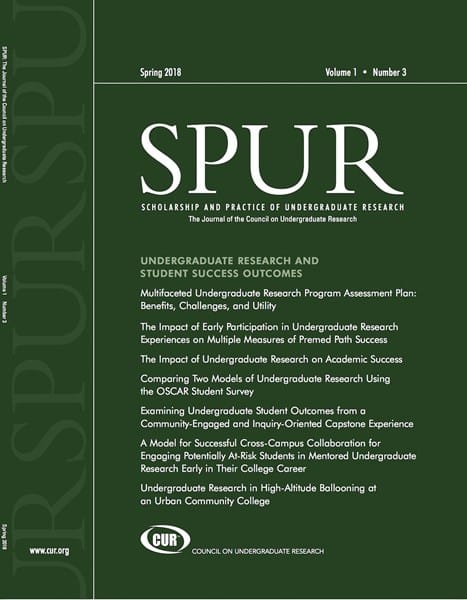SPUR (2018) 1 (3): https://doi.org/10.18833/spur/1/3/11
More Articles in this Issue
- Vignette‐ Regina Sullivan, Raji Subramaniam, and Patricia Schneider
SPUR (2018) 1 (3): https://doi.org/10.18833/spur/1/3/5 - Vignette‐ Elizabeth Easley and Sarah Hunt Sellhorst
SPUR (2018) 1 (3): https://doi.org/10.18833/spur/1/3/4 - Vignette‐ Frances Shen, Keenan Dungey, Brian Kahn, John Laubersheimer, Tarah Sweeting-Trotter, Alexander Skarr, Sudeep Sharma, Ben Walsh, and Holly Kent
SPUR (2018) 1 (3): https://doi.org/10.18833/spur/1/3/3 - Vignette‐ Jacob Alan English and Christina Wan
SPUR (2018) 1 (3): https://doi.org/10.18833/spur/1/3/2 - Vignette‐ Laura A. Pawlow and Elizabeth J. Meinz
SPUR (2018) 1 (3): https://doi.org/10.18833/spur/1/3/1 - Practice‐ Thomas B. Higgins, Bernhard Beck-Winchatz, Michael Davis, and Andrew Kruger
SPUR (2018) 1 (3): https://doi.org/10.18833/spur/1/3/14 Abstract:The authors describe an undergraduate research program at the City Colleges of Chicago (CCC) organized around high-altitude ballooning and carried out primarily in an open, maker-space environment. Two cohorts of students were recruited. They undertook projects in biology, chemistry, engineering, environmental science, and physics. Via the Undergraduate Research Student Self-Assessment, both cohorts reported positive gains. The 2016 cohort was assessed immediately after the program ended, and the 2015 cohort was assessed one year afterward, suggesting the benefits of the program persisted for at least a year. Longitudinal data showed that the students completed degrees or transferred at rates higher than the general CCC student population. These data indicate that students benefited from their experiences and developed identities as scientists and engineers.
- Assessment‐ Laura Pawlow and Kristen Sleeper
SPUR (2018) 1 (3): https://doi.org/10.18833/spur/1/3/9 Abstract:Southern Illinois University Edwardsville’s multiple techniques for assessing its Undergraduate Research and Creative Activities program seek to address both bigpicture concerns (e.g., are students learning?) and more pragmatic questions (e.g., are there barriers to participation?). The benefits and challenges of the quantitative and qualitative measures employed and the data’s role in program development are discussed. Strategies include tracking faculty and student participation to determine overall interest, growth, and satisfaction and to measure demographic and academic discipline participation. Faculty and student participants also complete anonymous exit surveys regarding student learning as conceptualized within seven academic themes, as well as satisfaction with the program and program-related professional development. In addition, the rate at which student participants coauthor scholarly work that is accepted in peer-reviewed professional outlets is tracked.
- Assessment‐ Stephanie L. Foster and Bethany M. Usher
SPUR (2018) 1 (3): https://doi.org/10.18833/spur/1/3/6 Abstract:This article discusses George Mason University’s locally developed assessment survey instrument, the OSCAR Student Survey, in which students self-report on learning outcomes, attitudes, goals, personal and professional growth, and satisfaction items. Development of the instrument is discussed, as well as the methods used to achieve construct validity. Results are compared from 2013–2016 student participation in the individually mentored Undergraduate Research Scholars Program (URSP) and Mason’s Research- and Scholarship-Intensive (RS) courses, which are capstone-style research courses for seniors. Both groups reported highly positive attitudes and experiences overall, yet an independent samples Mann-Whitney U test revealed that URSP students reported significantly more positive attitudes about doing research, and more personal and professional development at the end of their experience. URSP students reported dramatically higher rates of learning on several inquiry outcomes. Limitations and implications for use in program assessment are presented.
- Assessment‐ Michelle Samura
SPUR (2018) 1 (3): https://doi.org/10.18833/spur/1/3/15 Abstract:Although educational research indicates that undergraduate student participation in research, fieldwork, and/or community engagement has great value, there remains a dearth of information on student outcomes from participation in these activities. Drawing on high-impact educational practices as the conceptual framework, this article examines self-reported outcomes from participants in an intensive, one-year capstone experience for fourth-year students that was composed of fieldwork and research. Qualitative analysis of end-of-semester student reflections indicated that research primarily contributed to students’ academic development, fieldwork contributed to professional development, and the capstone course contributed to the personal and social development of students. Findings suggest that the combination of highimpact practices in a capstone experience may lead to the development of more engaged, prepared, and proactive professionals and citizens.
- Article‐ Michael S. Springer, John F. Barthell, Charlotte K. Simmons, Dana Jackson-Hardwick, and Gregory M. Wilson
SPUR (2018) 1 (3): https://doi.org/10.18833/spur/1/3/10 Abstract:The clear and tangible benefits attributed to taking part in undergraduate research and creative experiences are leading colleges and universities to seek ways to broaden participation among students in all academic disciplines, particularly those beyond the STEM fields. The Office of High-Impact Practices was established in 2014 at the University of Central Oklahoma to promote undergraduate research and creative experiences across the university. Its creation, overall description, and successes in broadening participation as well as the steps taken and lessons learned are discussed. The office has led to a broader vision of undergraduate research in the context of other high-impact teaching practices, with increased participation among students in colleges not traditionally represented in large numbers, namely the College of Liberal Arts and College of Fine Arts and Design.


